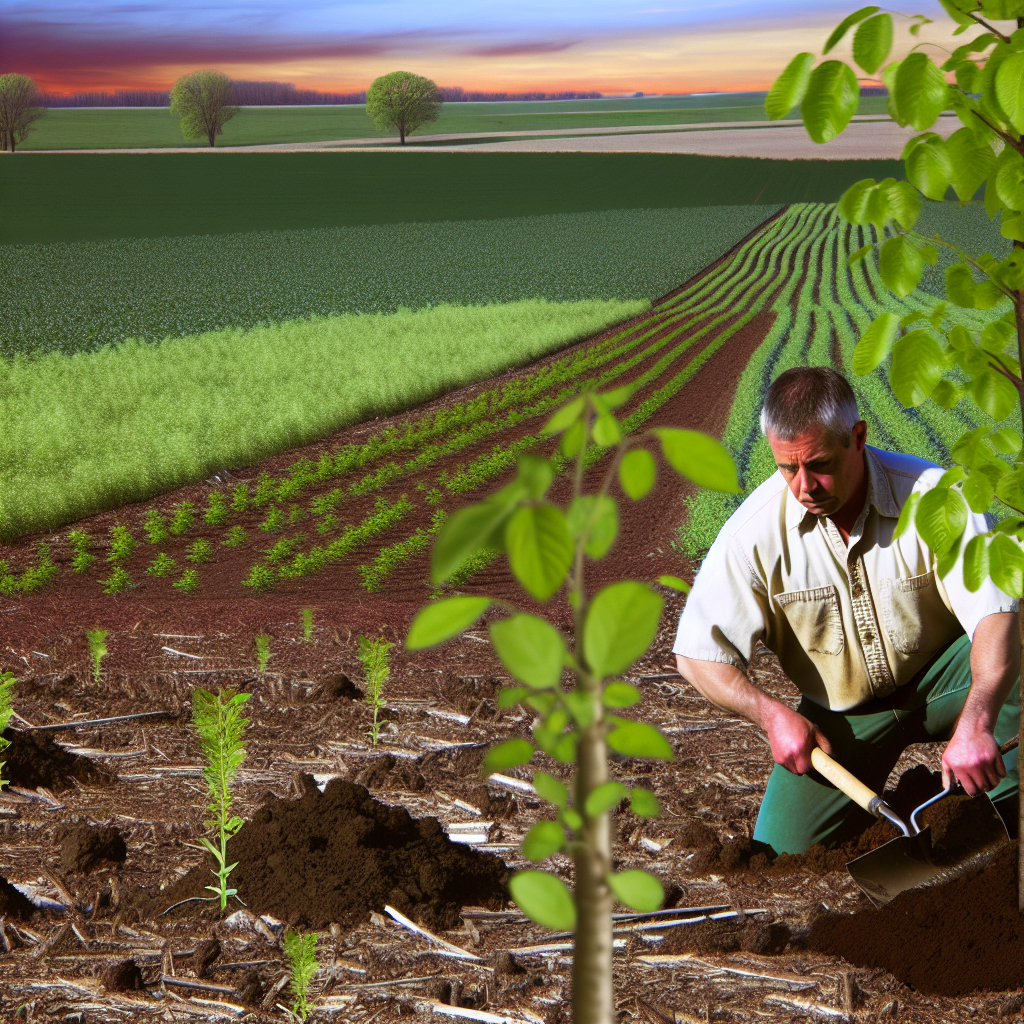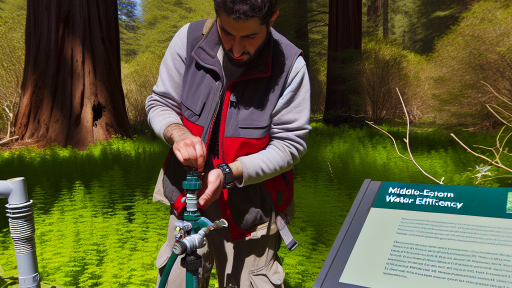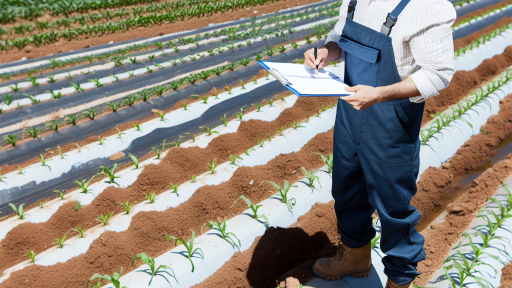Introduction to Carbon Sequestration and its Importance in Agriculture
Carbon sequestration refers to the process of capturing and storing atmospheric carbon dioxide.
This process plays a crucial role in mitigating climate change.
Agricultural practices can significantly enhance carbon sequestration in the soil.
Farmers can implement various methods to improve soil health and minimize carbon emissions.
This approach benefits not only the environment but also agricultural productivity.
The Role of Agriculture in Carbon Dynamics
Agriculture contributes to both carbon release and sequestration.
While traditional farming practices often lead to carbon loss, innovative methods can reverse this trend.
Carbon dioxide emissions primarily arise from soil disturbance and excessive fertilizer use.
Implementing sustainable practices helps sequester carbon and improves soil structure.
Healthy soil is vital for robust crop production and ecosystem stability.
Benefits of Carbon Sequestration
Enhancing carbon sequestration offers numerous advantages for farmers.
- It improves soil fertility and structure.
- It reduces the need for chemical fertilizers.
- It fosters biodiversity in agricultural systems.
- It increases resilience to climate variability.
These benefits ultimately contribute to long-term agricultural sustainability.
Future Implications
As global temperature rises, enhancing carbon sequestration becomes increasingly essential.
Farmers may find new markets for carbon credits, offering economic incentives.
Adopting carbon-friendly practices can improve land use while combating climate change.
Transform Your Agribusiness
Unlock your farm's potential with expert advice tailored to your needs. Get actionable steps that drive real results.
Get StartedThus, the role of carbon sequestration in agriculture is both proactive and reactive.
Investments in educational programs will empower farmers to embrace these practices.
What are Cover Crops?
Definition
Cover crops are plants grown primarily for soil health benefits.
They help improve soil structure, prevent erosion, and enhance nutrient cycling.
Farmers often use them between main crop cycles.
These crops can be a mixture of grasses, legumes, and other species.
Types of Cover Crops
Cover crops can be classified into various categories based on their characteristics.
Leguminous Cover Crops
Legumes are popular cover crops due to their nitrogen-fixing abilities.
They enrich the soil by converting atmospheric nitrogen into a usable form.
Examples of leguminous cover crops include clover, vetch, and peas.
Grassy Cover Crops
Grassy cover crops are effective for biomass production and soil protection.
They create a dense root system that reduces erosion.
Common grassy cover crops include rye, oats, and barley.
Brassicas
Brassicas, like radishes and mustards, enhance soil structure significantly.
Their deep roots help break up compacted soil layers.
They also suppress weeds and can manage pests effectively.
Purpose of Cover Crops
The primary purpose is to maintain soil health and fertility.
They capture excess nutrients from leaching and improve soil organic matter.
Additionally, cover crops provide habitat for beneficial organisms.
Using cover crops contributes to improved carbon sequestration.
The Role of Cover Crops in Enhancing Soil Health
Improving Soil Structure
Cover crops help improve soil structure significantly.
They enhance the aggregation of soil particles.
This leads to better aeration and water infiltration.
As a result, plants can access nutrients more effectively.
Showcase Your Farming Business
Publish your professional farming services profile on our blog for a one-time fee of $200 and reach a dedicated audience of farmers and agribusiness owners.
Publish Your ProfilePromoting Soil Fertility
Cover crops contribute to soil fertility in various ways.
They fix atmospheric nitrogen through their roots.
This process enriches the soil naturally.
Moreover, decomposing cover crops add organic matter.
Organic matter boosts soil nutrient content.
Reducing Erosion
Cover crops play a critical role in preventing soil erosion.
Their root systems hold soil in place.
Moreover, they protect against water and wind erosion.
Consequently, farmland remains productive and healthy.
Enhancing Microbial Activity
Cover crops promote beneficial microbial activity in the soil.
Their diverse plant roots create a habitat for microbes.
These microbes contribute to nutrient cycling and decomposition.
Healthy microbial communities improve overall soil health.
Optimizing Water Management
Cover crops optimize water management in agricultural systems.
They help retain moisture in the soil during dry periods.
Additionally, cover crops reduce surface runoff during heavy rains.
This leads to improved water availability for crops.
Encouraging Biodiversity
Incorporating cover crops promotes biodiversity in the ecosystem.
Diverse plant species attract various beneficial insects.
This boosts pollination and pest control on farms.
Ultimately, biodiversity enhances the resilience of agricultural systems.
See Related Content: Sustainable Approaches to Farm Byproduct Recycling
Mechanisms of Carbon Sequestration through Cover Crops
Root Development
Cover crops grow extensive root systems in the soil.
These roots enhance soil structure and stability.
Consequently, they create pathways for water and air flow.
Furthermore, root decay contributes to organic matter accumulation.
Soil Organic Carbon Increase
Cover crops significantly increase soil organic carbon levels.
This process occurs as crops capture carbon dioxide during photosynthesis.
They convert this carbon dioxide into organic compounds.
Subsequently, these compounds decompose and enrich the soil.
Nitrogen Fixation
Certain cover crops, like legumes, fix atmospheric nitrogen.
This nitrogen becomes available for subsequent crops.
Enhanced nitrogen levels support plant growth and carbon capture.
In this manner, cover crops promote sustainable agriculture practices.
Reduced Soil Erosion
Cover crops protect the soil surface from erosion.
This protection maintains soil health and carbon levels.
Roots anchor the soil, preventing loss during storms or strong winds.
Additionally, they support beneficial microorganisms in the soil.
Improved Water Retention
Cover crops enhance soil’s ability to retain water.
They reduce runoff and increase infiltration during rainfall.
Showcase Your Farming Business
Publish your professional farming services profile on our blog for a one-time fee of $200 and reach a dedicated audience of farmers and agribusiness owners.
Publish Your ProfileThis moisture retention allows for better growth conditions.
As a result, it supports carbon storage in the soil over time.
Find Out More: Drought-Resistant Crop Selection for Water Savings
Optimal Cover Crop Species for Different Climates and Soils
Tropical Climates
Tropical climates experience warm temperatures year-round.
Cover crops in these regions should thrive in heat and resist drought.
Legumes, such as cowpeas and pigeon peas, are excellent choices.
Additionally, sorghum-sudangrass offers excellent biomass production.
These crops provide nutrients while improving soil health.
Temperate Climates
Temperate climates have distinct seasons with varying temperatures.
In these regions, brassicas like red clover and mustard work well.
They enhance nutrient cycling and suppress weeds effectively.
Winter rye offers winter hardiness and helps prevent erosion.
These crops contribute to robust soil structure and fertility.
Arid Regions
In arid regions, water conservation becomes essential.
Cover crops should be drought-tolerant and deep-rooted.
Examples include chickpeas and barley, which adapt well to dry conditions.
These species help improve soil moisture retention over time.
Implementing them can significantly increase soil organic matter.
Clay Soils
Clay soils present unique challenges like compaction and poor drainage.
Cover crops should help improve soil structure in these areas.
Deep-rooted species like radishes can break up compacted layers.
Additionally, legumes like vetch enhance nitrogen levels naturally.
These practices lead to healthier, more productive soils.
Sandy Soils
Sandy soils drain quickly but often lack nutrient retention.
Cover crops in these areas must help build organic matter.
Species like buckwheat and clover provide excellent ground cover.
They improve soil fertility and prevent nutrient leaching.
Using these crops can greatly enhance sandy soil health over time.
Implementing Cover Crops Effectively
Selecting the right cover crop requires considering local conditions.
Farmers should assess their soil type, climate, and specific needs.
Experimenting with various combinations can yield the best results.
Additionally, timing plays a crucial role in crop success.
Proper planning ensures optimal growth and maximum benefits.
See Related Content: Agroforestry Planning And Design For Sustainable Farms

Case Studies: Successful Implementation of Cover Crops for Carbon Sequestration
Introduction to Case Studies
This section presents real-world examples of cover crops enhancing carbon sequestration.
We explore diverse agricultural practices across various regions.
Each case highlights unique farming techniques and outcomes.
Case Study: Johnson Family Farms
Johnson Family Farms in Iowa adopted cover crops three years ago.
They primarily use cereal rye and clover.
These crops significantly improve soil organic matter.
Showcase Your Farming Business
Publish your professional farming services profile on our blog for a one-time fee of $200 and reach a dedicated audience of farmers and agribusiness owners.
Publish Your ProfileAs a result, their carbon sequestration levels increased by 15%.
Additionally, they observed enhanced biodiversity in their fields.
Farmers reported fewer weed issues during the growing season.
Case Study: Green Valley Organic Farms
Green Valley Organic Farms in California implemented a diverse cover crop mix.
This mix includes vetch, peas, and radishes.
The farmers noticed improved soil structure and water retention.
Over two years, their soil carbon levels rose by 20%.
Moreover, these practices reduced erosion significantly.
Community workshops helped educate other farmers on this approach.
Case Study: Maplewood Agri-Tech
Maplewood Agri-Tech in Ohio focuses on innovative technologies with cover crops.
Their use of precision agriculture tools ensures optimal planting strategies.
They utilize a combination of oats and turnips.
Soil tests indicated a 30% increase in carbon storage within three years.
Further, crop yields improved as a direct result of healthier soils.
Case Study: Coastal Plains Farm Cooperative
Coastal Plains Farm Cooperative in Florida adopted cover crops to combat climate change.
They integrated sunflowers and buckwheat into their rotation.
The diverse root systems enhanced soil aeration and nutrient cycling.
The cooperative reported a 12% increase in carbon sequestered annually.
Moreover, the cooperative’s farms witnessed improved pest control methods.
Lessons Learned from Case Studies
These case studies demonstrate the effectiveness of cover crops.
Each farm experienced improved soil health and greater carbon sequestration.
Collaborative efforts among farmers facilitated knowledge sharing.
Continued research and development are critical for future advancements.
Implementing cover cropping benefits both the environment and agriculture.
Explore Further: Conservation Tillage Practices For Small Farms
Challenges and Considerations for Farmers Adopting Cover Crops
Understanding Economic Impacts
Farmers often face initial financial costs when adopting cover crops.
These costs include seed, labor, and equipment expenses.
Therefore, evaluating long-term benefits is crucial.
Increased soil health can reduce future input costs.
Moreover, many farmers may qualify for government grants or programs.
Climate and Environmental Conditions
Cover crops must be suitable for local climates.
Farmers need to select species that thrive in their conditions.
Variable weather patterns can affect cover crop performance.
Extreme drought or excessive rainfall can hinder growth.
Consequently, careful planning and monitoring are imperative.
Management and Maintenance Practices
Effective management strategies are vital for success.
Farmers must consider the timing of planting and termination.
Improper timing can lead to competition with cash crops.
Additionally, some farmers may require new equipment for management.
Investing in training can enhance management skills over time.
Showcase Your Farming Business
Publish your professional farming services profile on our blog for a one-time fee of $200 and reach a dedicated audience of farmers and agribusiness owners.
Publish Your ProfilePotential Pests and Disease Issues
Cover crops can attract pests or diseases, impacting cash crops.
Farmers should implement monitoring practices to address issues.
Crop rotation can help mitigate pest problems as well.
Choosing disease-resistant cover crop varieties can also minimize risks.
Socioeconomic Factors
Farmers in rural areas may have limited access to cover crop resources.
Networking with local agricultural extensions can provide valuable support.
Community education programs can boost knowledge about cover crops.
Engaging with peer farmers can foster collaboration and sharing.
Long-term Commitment to Practices
Farmers must be prepared for a long-term commitment to cover crops.
Changing traditional farming practices can require extensive planning.
Short-term results may not be immediately visible, requiring patience.
Continued education about sustainable farming practices is beneficial.
Building resilience against climate change enhances overall farming sustainability.
Future Perspectives: Research and Innovations in Cover Crop Management
Advancements in Crop Selection
Researchers are continuously exploring new cover crop varieties.
These varieties enhance soil health and improve carbon sequestration.
Innovation in crop selection focuses on resilience to climate challenges.
Moreover, diverse cover crops can support local ecosystems.
Integrative Management Practices
Holistic management practices are gaining prominence in agriculture.
This approach combines traditional techniques with modern technology.
For instance, soil health monitoring tools improve decision-making.
Additionally, precision agriculture optimizes cover crop deployment.
Innovative Funding Models
New funding models are emerging to support cover crop initiatives.
Agencies are providing financial incentives for sustainable practices.
Public-private partnerships are showcasing effective funding strategies.
Farming organizations play a crucial role in advocating for support.
Collaboration and Knowledge Sharing
Collaboration between researchers and farmers is essential for progress.
Field trials generate valuable insights into effective practices.
Moreover, knowledge-sharing platforms facilitate information exchange.
Ultimately, this teamwork drives innovation in farming strategies.
Impact of Technology on Agriculture
Emerging technologies are transforming cover crop management.
Drones and satellite imagery enhance monitoring capabilities.
Data analytics provide farmers with actionable insights.
Consequently, technology enables more efficient resource use.
Future Research Directions
Future research will likely focus on climate resilience in cover crops.
Integrating diverse species can boost ecosystem benefits.
Furthermore, studies will examine long-term effects on soil carbon levels.
This knowledge will inform better practices in agriculture.
Additional Resources
Cover Crops’ Climate Hype | The Breakthrough Institute
Partnerships for Climate-Smart Commodities Project Summaries …




